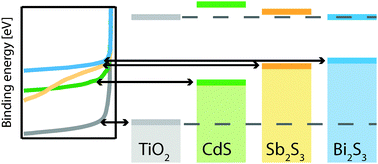Energy level alignment in TiO2/metal sulfide/polymer interfaces for solar cell applications
Abstract
Semiconductor sensitized solar cell interfaces have been studied with photoelectron spectroscopy to understand the interfacial electronic structures. In particular, the experimental energy level alignment has been determined for complete TiO2/metal sulfide/polymer interfaces. For the metal sulfides CdS, Sb2S3 and Bi2S3 deposited from single source metal xanthate precursors, it was shown that both driving forces for electron injection into TiO2 and hole transfer to the polymer decrease for narrower bandgaps. The energy level alignment results were used in the discussion of the function of solar cells with the same metal sulfides as light absorbers. For example Sb2S3 showed the most favourable energy level alignment with 0.3 eV driving force for electron injection and 0.4 eV driving force for hole transfer and also the most efficient solar cells due to high photocurrent generation. The energy level alignment of the TiO2/Bi2S3 interface on the other hand showed no driving force for electron injection to TiO2, and the performance of the corresponding solar cell was very low.


 Please wait while we load your content...
Please wait while we load your content...